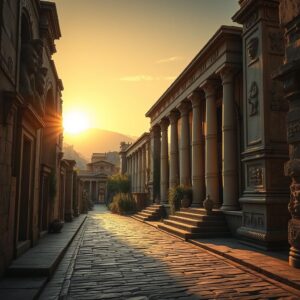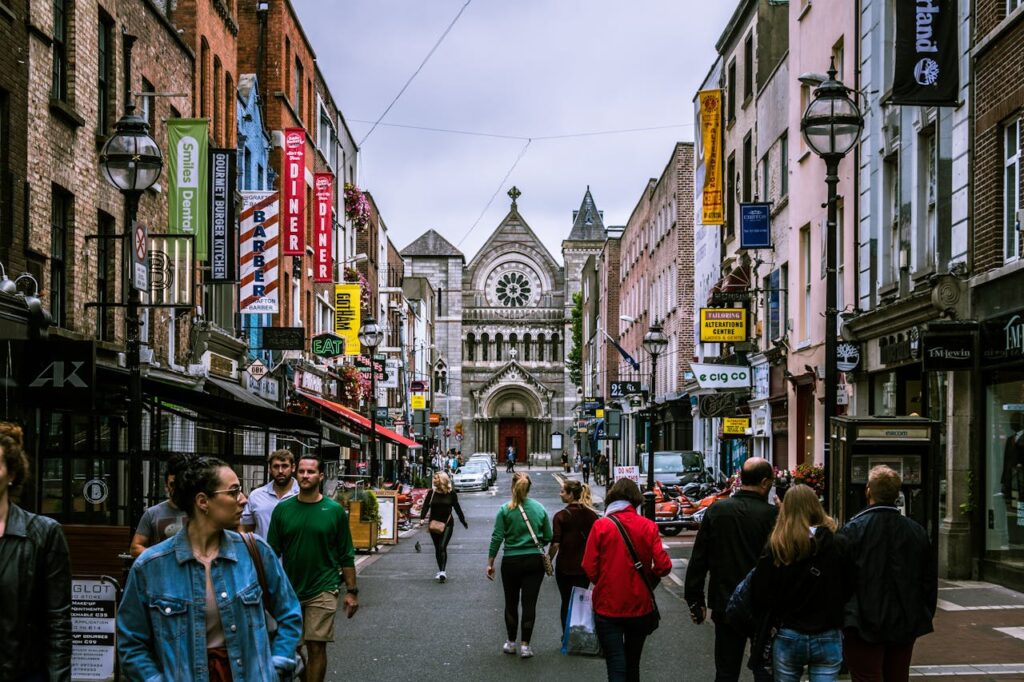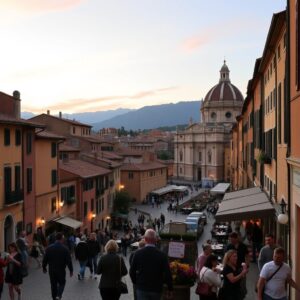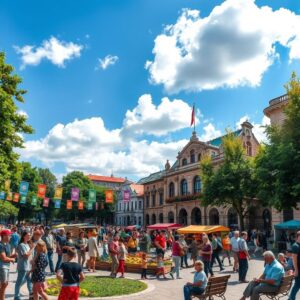
Explore & Play
Discover interesting topics and solve the accompanying crossword puzzle.
Capital City Crossword | Dive Into Global Capitals
Table of Contents
Welcome to our exploration of the world’s most iconic capital cities! To start, we invite you to test your geographical knowledge with our engaging Capital City Crossword. If you’re familiar with the topic, dive into the crossword first and see how many capitals you can identify. However, if you’re new to the subject or want to learn more about each capital city, we recommend reading the detailed article first. Once you’re equipped with more knowledge, return to the crossword for an extra challenge. Enjoy your journey through these fascinating cities!
Capital City Crossword
You can either fill in the crossword puzzle directly on this page or click the button in the bottom right corner to print it for free.

Exploring the World’s Capitals: A Journey Through Iconic Cities
Capital cities around the globe offer a fascinating glimpse into the history, culture, and identity of their nations. Each capital is a tapestry woven from historical events, cultural influences, and architectural marvels. In this article, we will embark on a journey through some of the world’s most iconic capitals, exploring their landmarks, histories, and unique characteristics. Our adventure will also touch upon how these cities have inspired and appeared in crossword puzzles, adding an element of fun and engagement to our exploration.
North America’s Vibrant Capitals
Washington, D.C.
As the capital of the United States, Washington, D.C. is a hub of political power and historic landmarks. Established as the nation’s capital in 1790, this city is home to some of the most recognizable structures in the country. The White House, the residence of every U.S. President since John Adams, stands as a symbol of American democracy. Nearby, the Capitol Building serves as the seat of the U.S. Congress, where laws are debated and enacted.
In addition to these political landmarks, Washington offers cultural treasures like the Smithsonian Museums, which are free to the public. The National Mall, a vast green space dotted with monuments such as the Washington Monument and Lincoln Memorial, provides a scenic backdrop for reflecting on the nation’s history. Vibrant neighborhoods like Georgetown add to the city’s charm with their historic buildings and diverse dining options.
Ottawa
Nestled along the Ottawa River, Canada’s capital, Ottawa, combines political significance with scenic beauty. Unlike many capitals, Ottawa’s Parliament Hill, with its Gothic Revival architecture, is a centerpiece of Canadian democracy and a popular tourist attraction. The Rideau Canal, a UNESCO World Heritage site, transforms into the world’s largest naturally frozen skating rink during the winter months, offering a unique way to experience Canadian culture.
The city is also known for its cultural institutions, such as the National Gallery of Canada and the Canadian Museum of History. Ottawa’s vibrant festivals, including Winterlude and the Canadian Tulip Festival, celebrate the changing seasons and the diverse cultural heritage of the nation.
Europe’s Historic and Modern Capitals
Paris
Paris, the capital of France, is renowned for its romantic ambiance and historical monuments. The Eiffel Tower, constructed for the 1889 Exposition Universelle, remains one of the most visited landmarks in the world. The Louvre Museum, home to thousands of works of art including the Mona Lisa, is a testament to Paris’s rich artistic heritage.
Beyond its iconic landmarks, Paris is famous for its café culture and sophisticated fashion scene. The city’s charming neighborhoods, such as Montmartre and Le Marais, offer a glimpse into its artistic history and contemporary lifestyle. Paris’s blend of history and modernity makes it a must-visit destination for travelers seeking both cultural and historical enrichment.
London
As the capital of the United Kingdom, London is a city steeped in history and modernity. The cityscape is punctuated by landmarks like Big Ben and the London Eye, which offer stunning views of the Thames River and the city’s sprawling urban landscape. Buckingham Palace, the official residence of the British monarch, hosts the famous Changing of the Guard ceremony, drawing visitors from around the world.
London’s rich history is further explored through its numerous museums, such as the British Museum and the Natural History Museum. The West End theaters provide world-class entertainment, showcasing everything from classic plays to contemporary musicals. London’s ability to blend its historical significance with modern innovations makes it a dynamic metropolis.
Berlin
Berlin, Germany’s capital, is known for its rich history and vibrant cultural scene. The Brandenburg Gate, a symbol of unity, was once a checkpoint during the Cold War and now stands as a monument to Germany’s reunification. The Berlin Wall Memorial and East Side Gallery offer poignant reminders of the city’s divided past.
Museum Island, a UNESCO World Heritage site, houses several renowned museums, including the Pergamon Museum and the Alte Nationalgalerie. Berlin’s contemporary art scene thrives in neighborhoods like Kreuzberg and Mitte, where street art and galleries reflect the city’s ongoing evolution. Berlin’s ability to embrace its historical roots while celebrating modern culture defines its unique character.
Rome
Rome, the capital of Italy, is a treasure trove of ancient ruins and Renaissance art. The Colosseum, an ancient amphitheater, stands as a testament to Rome’s imperial grandeur. Nearby, the Vatican City, an independent city-state within Rome, is home to St. Peter’s Basilica and the Sistine Chapel, where Michelangelo’s frescoes captivate visitors.
Rome’s historic piazzas, such as Piazza Navona and Piazza di Spagna, offer a glimpse into the city’s vibrant public life. Italian cuisine, with its focus on fresh ingredients and traditional recipes, adds to the city’s allure. Rome’s rich tapestry of history, art, and culinary delights makes it a quintessential destination for history enthusiasts and food lovers alike.
Athens
Athens, the capital of Greece, is the cradle of Western civilization with its remarkable ancient ruins. The Acropolis, an ancient citadel overlooking the city, houses the Parthenon, a temple dedicated to the goddess Athena. The Ancient Agora, once the heart of public life, provides insights into classical Athens.
Modern Athens is a bustling metropolis where ancient history meets contemporary living. The city’s vibrant street life, outdoor markets, and traditional tavernas reflect its dynamic culture. Athens’s blend of historical significance and modern energy makes it a fascinating destination for those interested in the roots of Western culture.
Oslo
Oslo, the capital of Norway, is a city known for its stunning natural beauty and rich cultural life. Surrounded by fjords and forests, Oslo seamlessly blends urban living with outdoor activities. The Oslo Opera House, with its striking modern architecture, offers spectacular views of the harbor and is a focal point of the city’s cultural scene.
The Viking Ship Museum, housing well-preserved Viking ships, provides a fascinating glimpse into Norway’s ancient maritime history. Additionally, the Vigeland Park, with its unique collection of sculptures, showcases the city’s dedication to public art. Oslo’s harmonious mix of nature and culture makes it an inviting destination for those seeking both relaxation and enrichment.
Asia’s Dynamic Capitals
Tokyo
Tokyo, Japan’s bustling capital, offers a unique blend of futuristic technology and traditional culture. The Tokyo Tower, inspired by Paris’s Eiffel Tower, provides panoramic views of the city’s sprawling urban landscape. Shibuya Crossing, one of the world’s busiest pedestrian crossings, exemplifies Tokyo’s vibrant energy.
The city’s cultural heritage is preserved in historic sites like Senso-ji Temple and the Meiji Shrine. Tokyo’s culinary scene, known for its sushi and ramen, reflects the city’s blend of tradition and innovation. Tokyo’s ability to harmonize its rich history with cutting-edge modernity defines its global appeal.
Beijing
The capital of China, Beijing, is a city where ancient history meets modern development. The Great Wall, stretching over 13,000 miles, offers a breathtaking glimpse into China’s past. The Forbidden City, a vast imperial palace complex, showcases the grandeur of Ming and Qing dynasties.
Beijing’s cultural landscape is enriched by historical sites such as Tiananmen Square and the Summer Palace. The city’s culinary scene, featuring Peking duck and traditional dumplings, provides a taste of its rich heritage. Beijing’s juxtaposition of ancient landmarks and contemporary progress illustrates its dynamic evolution.
Moscow
Moscow, the capital of Russia, is known for its grand architecture and historical significance. The Kremlin, a fortified complex housing the Russian government, is a symbol of political power. Red Square, with its striking St. Basil’s Cathedral, is a center of cultural and historical events.
Moscow’s vibrant cultural scene includes renowned institutions such as the Bolshoi Theatre and the Pushkin Museum of Fine Arts. The city’s rich literary and artistic heritage, combined with its modern developments, creates a unique blend of historical and contemporary influences. Moscow’s dynamic character offers a deep and multifaceted experience for visitors.
South America’s Cultural Capitals
Buenos Aires
Buenos Aires, Argentina’s capital, is a city famous for its rich cultural heritage and vibrant arts scene. The Casa Rosada, the presidential palace, is an iconic building with a pink façade that hosts significant political events. Teatro Colón, one of the world’s greatest opera houses, reflects the city’s dedication to the arts.
The neighborhood of La Boca, known for its colorful houses and tango performances, captures the city’s lively spirit. Buenos Aires’s culinary scene, featuring traditional Argentine steak and diverse international influences, complements its cultural vibrancy. The city’s dynamic blend of history, art, and gastronomy makes it a captivating destination.
Brasília
Brasília, the planned capital of Brazil, is renowned for its modernist architecture and unique city layout. Designed by architect Oscar Niemeyer and urban planner Lúcio Costa, the city’s innovative design includes the Cathedral of Brasília, with its striking futuristic architecture, and the Palácio da Alvorada, the official residence of the President.
The city’s urban planning emphasizes green spaces and organized sectors, offering a different experience compared to other capitals. Brasília’s role as a political and administrative center is complemented by its modernist aesthetic, making it a notable example of 20th-century urban design.
Oceania’s Unique Capitals
Canberra
Canberra, Australia’s capital, is a purpose-built city with a focus on national institutions and green spaces. Designed by architect Walter Burley Griffin, Canberra features Parliament House, a striking building that symbolizes Australian democracy. The Australian War Memorial, dedicated to soldiers who served in conflicts, offers a poignant reminder of the nation’s history.
Lake Burley Griffin, a central feature of the city, provides recreational opportunities and scenic views. Canberra’s commitment to environmental sustainability and its role as the seat of government make it a unique and integral part of Australia’s national identity.
Africa’s Historic Capitals
Cairo
Cairo, the capital of Egypt, is a gateway to ancient wonders and a vibrant urban experience. The Pyramids of Giza, with the Great Sphinx, are some of the most famous and enduring symbols of ancient Egypt. The Egyptian Museum, located in Cairo, houses an extensive collection of artifacts, including Tutankhamun’s treasures.
The bustling markets, such as Khan el-Khalili, offer a sensory overload of sights, sounds, and smells, reflecting Cairo’s dynamic street life. The city’s blend of ancient monuments and modern vibrancy captures the essence of Egypt’s rich cultural heritage.
Addis Ababa
Addis Ababa, Ethiopia’s capital, serves as the political and cultural center of the country. The African Union Headquarters, located in Addis Ababa, underscores the city’s role in continental diplomacy. The Holy Trinity Cathedral, an important religious site, and the National Museum, home to the famous fossil “Lucy,” offer insights into Ethiopia’s history and culture.
The city’s diverse population and rich traditions are reflected in its vibrant markets and cultural festivals. Addis Ababa’s blend of historical significance and contemporary growth makes it a key player in both Ethiopian and African contexts.
Smaller and Unique Capitals
Luxembourg City
Luxembourg City, the capital of Luxembourg, is known for its fortified old town and charming streets. The Bock Casemates, a network of underground tunnels, reflect the city’s military history. The Grand Ducal Palace, the official residence of the Grand Duke, stands as a symbol of Luxembourg’s monarchy.
The city’s blend of historic fortifications and modern amenities creates a unique atmosphere. Luxembourg City’s role as a financial hub and its picturesque setting make it an intriguing destination for travelers interested in both history and contemporary European life.
Andorra la Vella
Andorra la Vella, the capital of Andorra, is a small yet picturesque city nestled in the Pyrenees. The Casa de la Vall, a historic building, serves as the seat of Andorra’s parliament. The Grandvalira Ski Resort, located nearby, offers winter sports enthusiasts a popular destination.
The city’s blend of natural beauty and cultural heritage is complemented by its duty-free shopping and charming streets. Andorra la Vella’s unique setting and role as a political and economic center make it a noteworthy stop for those exploring the Pyrenees.
Lesser-Known Capitals
Vaduz
Vaduz, the capital of Liechtenstein, is known for its scenic beauty and impressive castle. Vaduz Castle, perched on a hill, serves as the official residence of the princely family. The Liechtenstein National Museum offers insights into the country’s history and culture.
The city’s compact size and picturesque setting make it a charming destination. Vaduz’s role as the political center of Liechtenstein, combined with its stunning alpine views, provides a unique experience for visitors.
Monaco
Monaco, the capital of the tiny principality of Monaco, is famous for its luxury lifestyle and casinos. The Casino de Monte-Carlo, an iconic landmark, attracts high rollers and tourists alike. The Prince’s Palace, with its stunning architecture and historic significance, is a symbol of Monaco’s royal heritage.
Monaco’s glamorous lifestyle, combined with its Mediterranean setting, makes it a popular destination for those seeking a taste of opulence. The city’s blend of luxury and natural beauty creates an unforgettable experience.
Discovering the Essence of Capitals
From ancient ruins to modern skyscrapers, the world’s capital cities reflect the diverse and dynamic nature of our global landscape. Each capital offers a unique story, whether through its historical landmarks, vibrant cultures, or architectural innovations. Exploring these cities provides insights into their past and present, enriching our understanding of global history and culture.
In this journey through iconic capitals, we’ve seen how these cities embody the essence of their nations, blending tradition with modernity and history with innovation. As we continue to explore the world, let these capitals inspire us to learn more about the rich tapestry of human civilization.
Incorporating capital cities into crossword puzzles offers a fun and engaging way to test geographical knowledge. These puzzles challenge solvers to recall various capitals, their unique features, and their significance. For example, capitals like Cairo and Tokyo, as well as more unique entries like Andorra la Vella, have all made appearances in crosswords, highlighting their global recognition.
Share to...
I hope you enjoy the content.
Want to receive our daily crossword puzzle or article? Subscribe!
You may also be interested in
Share to…
Want to receive our daily crossword puzzle?
-
Jigsaw Puzzles
Zodiac Ink Dog Puzzle: Artful Elegance 250 | 300 | 500 Pieces
kr 348,00 – kr 439,00Price range: kr 348,00 through kr 439,00 Select options This product has multiple variants. The options may be chosen on the product page -
Jigsaw Puzzles
Majestic Stag Watercolor Jigsaw Puzzle 250 | 300 | 500 Pieces
kr 348,00 – kr 439,00Price range: kr 348,00 through kr 439,00 Select options This product has multiple variants. The options may be chosen on the product page -
Jigsaw Puzzles
Nordkapp Abstract Art Jigsaw Puzzle 250 | 300 | 500 Pieces
kr 348,00 – kr 439,00Price range: kr 348,00 through kr 439,00 Select options This product has multiple variants. The options may be chosen on the product page

















